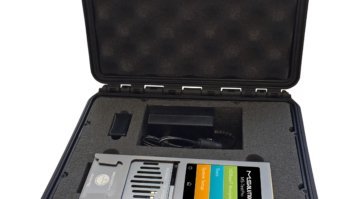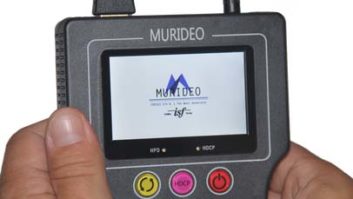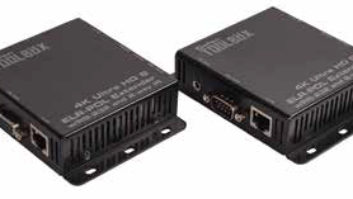One of the trends to come out of the most recent CEDIA EXPO was a proliferation of HDBaseT products designed to send high-definition digital video long distances over a single LAN cable technology.

Above: Kordz’s PLX-HDB.4 HDBaseT Extender enables the transport of uncompressed high speed HDMI, six-port Ethernet, IR, and RS232 data simultaneously over a single Cat-5e/6 cable up to 100m.
Marketed since June 2010 by the HDBaseT Alliance (LG Electronics, Samsung Electronics, Sony Pictures Entertainment, and Valens Semiconductor), HDBaseT technology converges uncompressed full HD digital video, audio, 100BaseT Ethernet, power over cable, and various control signals through a single 100-meter/328- foot Cat-5e/6 cable with RJ45 connectors. It enables uncompressed video/audio up to 10.2 Gbps, a maximum cable length of 100 meters, and support of multiple hops up to 8 x 100 meters. It also enables up to 100 watts of power, which can be utilized to power a remote TV.
With HDBaseT providing these uniform specs across all products manufactured from the standard, how are the companies that are selling these solutions able to set themselves apart from their competitors? For some people, like Kordz managing director David Meyer, the differences between HDBaseT offerings are as clear as those between the various manufacturers of seemingly similar HDMI cables.


Left: While acknowledging that the core of HDBaseT technology is the same for everyone, Atlona product manager Steve Heintz, product manager notes that his company’s matrix switches and extenders offer other unique features that set them apart from the pack. Right: Gefen president and CEO Hagai Gefen says his company prides itself on being the first to use HDBaseT technology and the first to be officially certified with HDBaseT in its products.
“Not all are built equal. If anyone suggests to me that they are, I just say to them, ‘Yeah, just like with HDMI products.’ They usually get it,” Meyer stated. “Valens [Semiconductor] have made a rather robust and powerful chipset, but the design of the PCB and combination of all other components that comprise the total circuit are critical in making a robust and reliable solution, and that’s where they differ.”
Meyer argued that it has “never really been HDMI’s fault” that it developed a reputation as a “plug-and-pray” solution; rather, it was the implementation by manufacturers that has caused the problems. Unfortunately, he noted, HDBaseT is “infinitely more complex, with HDMI making up just one part of it.” So, unless all manufacturers are all suddenly going to turn perfect, integrators should expect some variation in quality and reliability of HDBaseT-enabled devices, as well.
Nonetheless, Kordz is working to ensure its HDBaseT solutions are “robust and reliable,” offering what Meyer calls a “functional balance” of multiple formats optimized for the custom installer and smart system communications. In addition to “standard HDBaseT stuff” like high-speed levels at 10.2 Gbps, Kordz’s PLX-HDB.4 also supports upcoming UHD 4K and 1080p60 3D, as well as an HDMI audio return channel and RS232 bidirectional communication of all common RS232 protocols. Its six-port, full-duplex 100 Mbps Ethernet switch is divided into three at the source end and three at the display.
“It operates like a regular ethernet switch with internet input wherever it is most convenient,” Meyer said. “Assuming limited application for the HDMI ethernet channel at this time, the PLXHDB. 4 may alleviate the need for an Ethernet switch in the AV system, saving a couple hundred dollars.”


Transformative Engineering says its HD-1 extender was the first product to utilize every available HDBaseT function.
One hassle for installers of many HDMI extender systems, Meyer said, is the need to find a spare “mains power point” at the display side, from which to power the extender’s Rx unit. The PLXHDB. 4 utilizes the PoE capability of HDBaseT to carry to requisite power from Tx to Rx, so power is at the source side only. “Furthermore, we even down-convert the DC to 12 volts to power a connected IR extender system with target at the display and connecting block and emitters at the source side. There’s no need to separately power the IR,” Meyer said.
Matrix Switching
Steve Heintz, product manager for Atlona’s Professional Line, acknowledged that the core of HDBaseT technology is the same for everyone, so what really sets his company’s matrix switches and extenders apart from the pack are their other unique features. “For our matrix switches, this includes bidirectional RS-232 control for local video displays and bi-directional IR control through third-party control boxes,” he explained.
Atlona’s matrix switches, including the AT-PRO2HD88MSR and AT-PRO2HD1616M-SR, can program baud rates for RS- 232 communication of I/O matrix switching and output ports to local devices. The company’s extender kits, including the new ATDVI4- 100SR and AT-HD4-V110SR, provide Ethernet pass-through, plus bi-directional RS-232 and IR.
“The performance coupled with these features makes them an outstanding value,” Heintz said.
An HDBaseT Pioneer
Gefen prides itself on being the first to use HDBaseT technology and the first to be officially certified with HDBaseT in its products, according to its president and CEO Hagai Gefen. Being a pioneer of sorts for the new standard meant that Gefen had to first decide how the technology would fit into its existing line-up.
“We took the approach of identifying the products as ELR (extra long range) extenders that dedicate one cable for signal delivery up to 100 meters,” Gefen said. “Using HDBaseT enabled us to expand our range to offer both short and long-distance extenders using industrystandard Cat-X cables. Aside from our HDMI solutions, we have also implemented HDBaseT in our KVM (keyboard, video, mouse) extenders, which send DVI and USB over a single cable, and we also have a DVI with RS-232 solution, which is better for digital signage applications.”
Membership has Its Benefits
As a contributing member of the HDBaseT Alliance, Transformative Engineering has been privy to “unique applications of the technology,” according to company president Jay Trieber. From the beginning, the company chose to implement the highest levels of HDBaseT functionality in its products. For instance, its HD-1 extender was the first HDBaseT product to utilize every available function, including audio return channel (ARC), single-ended 24-volt power, full nine-pin RS232 control (as opposed to three-pin), and legacycompatible digital audio transfer via SPDIF and HDMI. The HD-1 is also the first HDMI extender to pass certification for both HDMI (the company’s a licensed HDMI adopter) and HDBaseT.
“This dual certification gives us unquestioned authority of our technical adherence to vital HDMI specifications and rules,” Trieber said. “Any incompatibility or operational inconsistencies now fall on the other parts of the HDMI eco-system, particularly any products not certified.”
As the HDBaseT technology continues to evolve, Trieber said, his company will add new features to its platform. “Also, in the not too distant future, we intend to offer an economy HDBaseT product, in a smaller package. This will allow installers to offer a quality HD extender in moderate-sized environments,” he said.
Integrator-Friendly Features
Acknowledging that there are many extender kits and baluns based on HDBaseT technology that do “a great job in extending HDMI signals,” KanexPro’s senior product and marketing manager Kashyap Khetia pointed out several key attributes of his company’s offerings that integrators sometimes overlook.
“Everyone these days touts full HD 1080p and 4K x 2K resolutions, [but] the fact is most of the applications where extenders are installed requires steady 720p or 1080i signals, keeping in mind that 1080p content is not readily available everywhere, and that’s where most of the baluns fail due to poor or no EDID management inside the baluns,” Khetia explained. “KanexPro 5PL offers intelligent EDID management that sources power up correctly, reliably outputting the content. Most importantly, pre-stored EDID acts as a emulator when a user selects different resolutions and refresh rates.”
KanexPro’s HDBASE5PL also incorporates power over Ethernet, which Khetia noted, eliminates the need for an additional power source for the receiver, “plus the unit saves energy by not being tethered to an AC outlet,” he said.
KanexPro 5PL also provides an additional Ethernet port on both sides, spreading Ethernet signals to connected TVs or computers for online access remotely over a single Cat- 5e/6/7 cable. “Some of the baluns in the market lack a key element, which is the serial control interface or RS-232. The KanexPro 5PL has RS- 232 on both sides, providing full control through with any thirdparty control system,” Khetia added.
A Perfect Combination
According to Accell director of marketing Michael Weizer, the UltraCat HD HDMI over Cat-5e HDBaseT extender set that his company launched in August includes a compelling combination of features, including RS232, Ethernet, and a bidirectional IR pass-through at a competitive MSRP of $499.95. But it didn’t start out that way back in January. When his company first demonstrated the concept version of the HDMI extender at CES 2011, an over-abundance of features created a product that was too bulky and had a relatively high resale price.
“We returned from CES with a goal to modify the UltraCat HD extenders, capturing a balance between functionality and price by integrating only core features into the product,” Weizer recalled. “We removed the HDMI bypass, additional Ethernet ports, and power over HDBaseT (POH), greatly reducing the size of the housings, as well as decreasing the product cost.”
Jeremy J. Glowacki is editorial director of Residential Systems.







